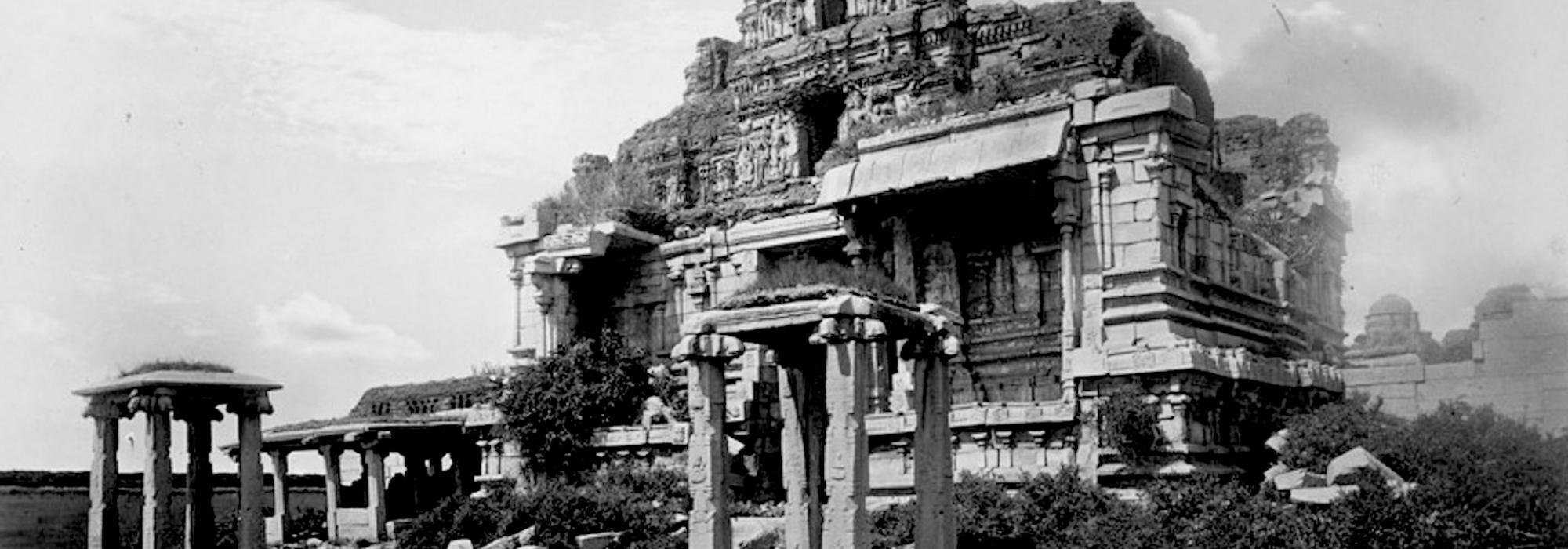Saletore minces no words when he writes that the Hoysala kings who made grants to pay off Jiyza at Varanasi so that Hindu pilgrims could visit in peace was a harbinger of worse things to hit south India: "this compulsory levy only put off the danger for a worse day." Indeed, Hindus had learned nothing until their most sacred Vishwanatha Temple was finally destroyed by Aurangzeb five hundred years later.
On the other side, Saletore writes with undisguised pride that the year 1346 CE witnessed south India "rise out from a period of 68 years of struggle, during which the intrepid hoofs of alien soldiers had defiled the Hindu country." He says in so many words that the Vijayanagara Empire was not only the visible embodiment of national resistance against Muslims but was an unprecedented epoch whose criticality can be gauged in light of Hindu empires that had fallen like ninepins throughout northern India.
The greatest heritage of the Vijayanagara monarchs was creating an atmosphere of goodwill and harmony in an era of political conquests, sectarian hostilities, and intense literary activity.
After centuries of unremitting strife, it is only under the fledgling Vijayanagara power that all Hindus in the south presented a united front for the first time -- chieftains, governors, etc., instead of declaring independence, willingly united under a strong banner.
We can examine a few more such examples from his work. Saletore poses this important question: why was there no revolution against the new Vijayanagara rulers? And he answers it beautifully by detailing out the bloodless transfer of power from the Hoysalas to the Sangama brothers and concludes as follows:
The vanishing Hoysala rulers [and]…the common people realised that the honour of their homes and the destiny of the country were safe in the hands of the descendants of Sangama…especially by understanding the ideal which the founders placed before themselves.
Saletore marshals a wealth of evidence that shows how the Vijayanagara rulers maintained the continuity of the principles which had guided the affairs of the Tamil and Karnataka lands from the dawn of history till the 14th century and took “extreme care with which they introduced any change either in the social or the political sphere."
Perhaps the most central feature and contribution of Saletore’s work on Vijayanagara is this: he was the first scholar to conclusively prove that the Vijayanagara Empire was founded by Kannadigas. The whole section dealing with this aspect is a prodigious feat in which Saletore’s scholarship slaughters a series of Western researchers including
Francis Buchanan, H.H. Wilson, Mark Wilks, Robert Sewell, Vincent Smith, Walter Eliot, and Lewis Rice all of whom attributed non-Kannada origins to the Vijayanagara Empire. Saletore’s tasty evisceration of these Western worthies is in the same the delightful tenor of P.V. Kane who performs a similar scholarly surgery of say, Jolly, Pargiter, Jacobi, Fleet, and Keilhorn.
Saletore finishes this virtuoso performance with words that once again resonate his enduring love, devotion and attachment to the Kannada Desha and its people:
Thus did Karnataka vindicate to the rest of the Hindu world her honour by sending forth a little band of five brothers, who, far from being “a stupid instrument for the renovation and restoration of Hinduism,” stood out, Karnataka by birth and Karnataka in valour, as the champions of all that was worth preserving in Hindu religion and culture.
Now we can quickly examine a few aspects of the density and attention to detail that Saletore’s work contains. In fact, his cultural sensibility shines excellently when he does a brilliant and minute analysis of the Vijayanagara Empire's "flowers, birds, and animals when compared with the principles of the Hindu writers on polity." Then a whole section on horses and elephants apart from its details, is deeply moving in many places.
Equally if not more brilliant is the portion describing town planning, road network, etc. Saletore’s descriptions of the major cities of the Empire actually makes us want to visit them. Then there is something to be said about how Saletore devotes more than fifty pages to arrive at the founding of the city called Vijayanagara. This whole section is a tour de force of scholarship bringing a full range of his erudition that includes astronomy, historical dating, epigraphy, comparative histories, and a sweeping knowledge of several languages both in their old and new forms.
Before moving on to the next topic, here is a tidbit from Saletore’s assessment of the magnanimity and nobility of the Vijayanagara rulers. Writing about the view of the Vijayanagara citizens on paying taxes, this is what Saletore writes:
Thus did the people colour a purely governmental affair--i.e., paying taxes--with the sanctity of a religious obligation.
We can conclude this discussion by giving a first-hand picture of the kind of hardships Saletore had to face while researching the work. Here are his own words:
The kind of work that has gone in for so many decades to reconstruct Vijayanagara History is only a painful testimony to the kind of devastation that occurred. Almost nothing sequential or logical historical material has survived. This is piecemeal reconstruction using multiple sources, multiple perspectives and is still subject to revision and newer discoveries.
And yet, Saletore was able to achieve this magnificent outcome.
Indeed, this is a crying shame even after seventy-five years of attaining an alleged independence: had this Vijayanagara research work pioneered by exemplars like Saletore continued with a pace, passion, dedication and resources it demands, we should've had a comprehensive, if not complete and truthful history of this glorious world-empire in multiple languages.
To be continued













































